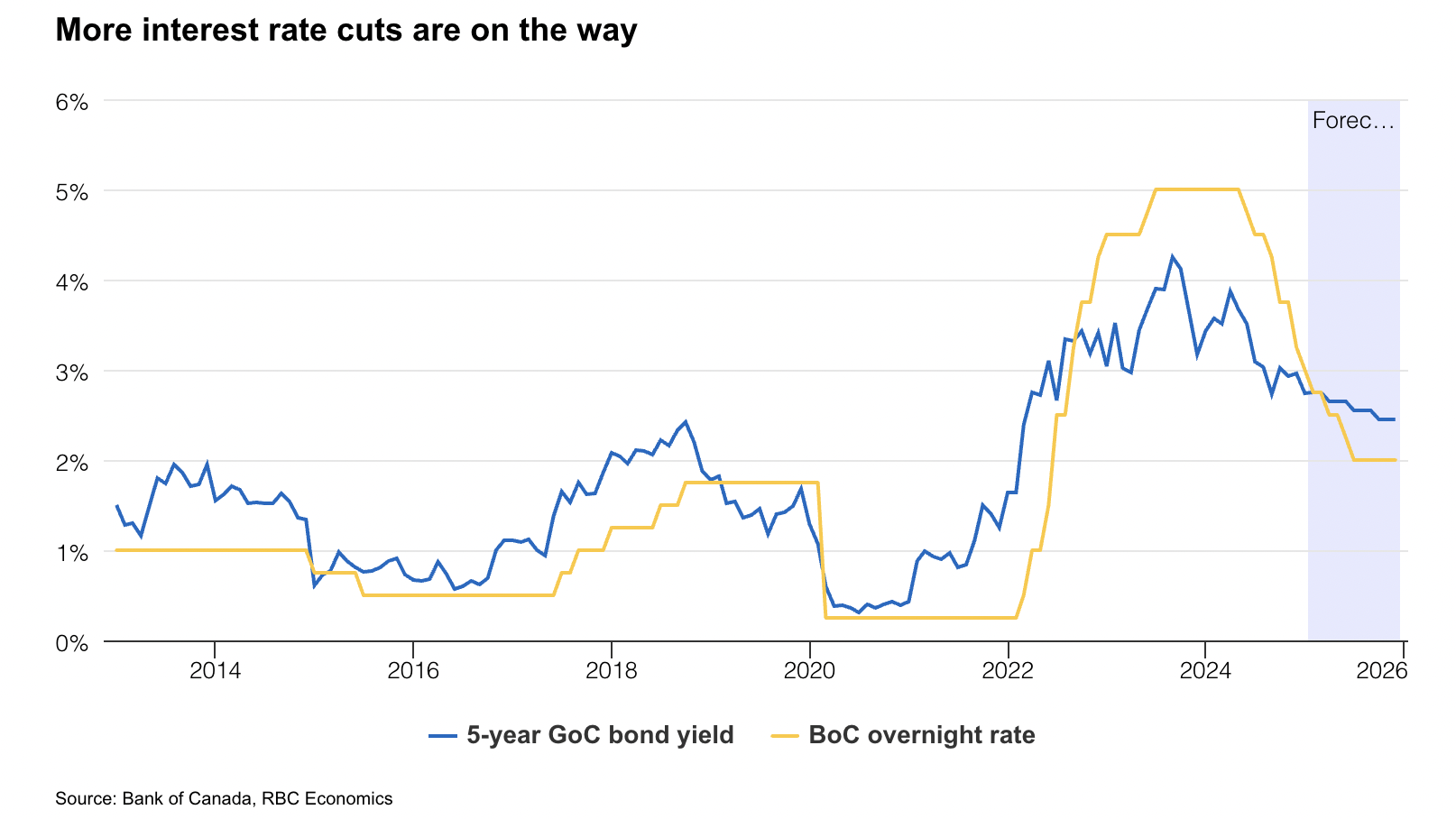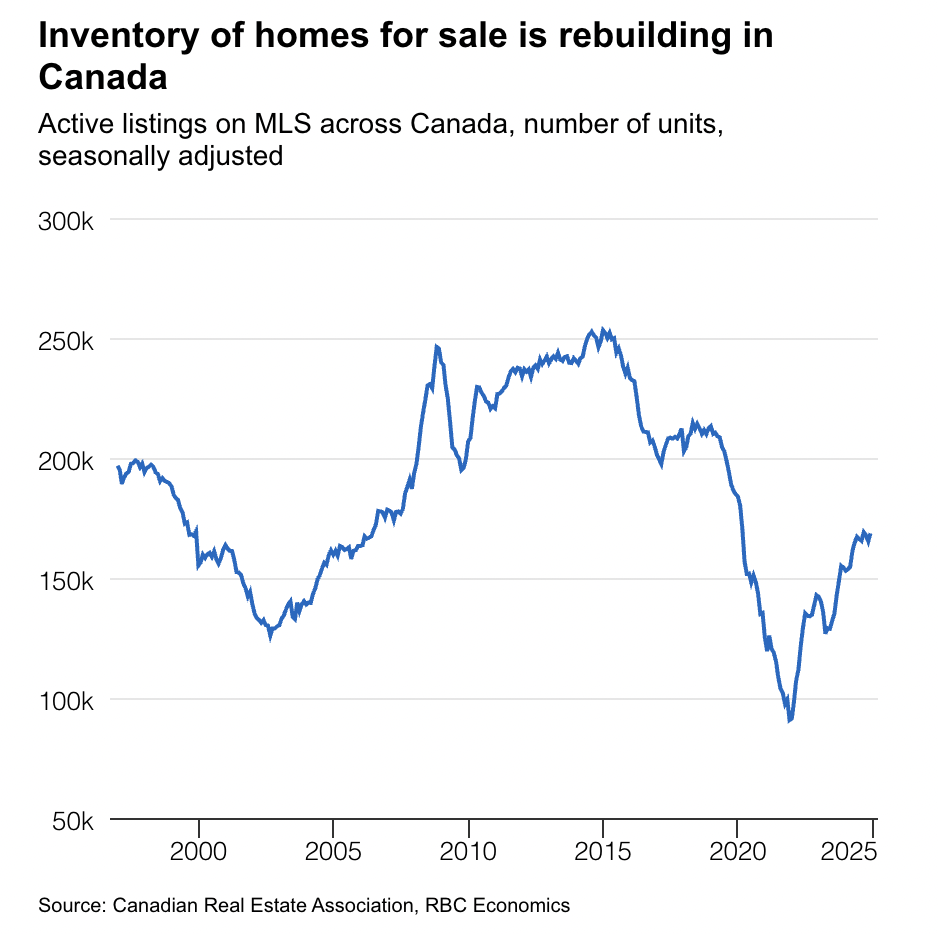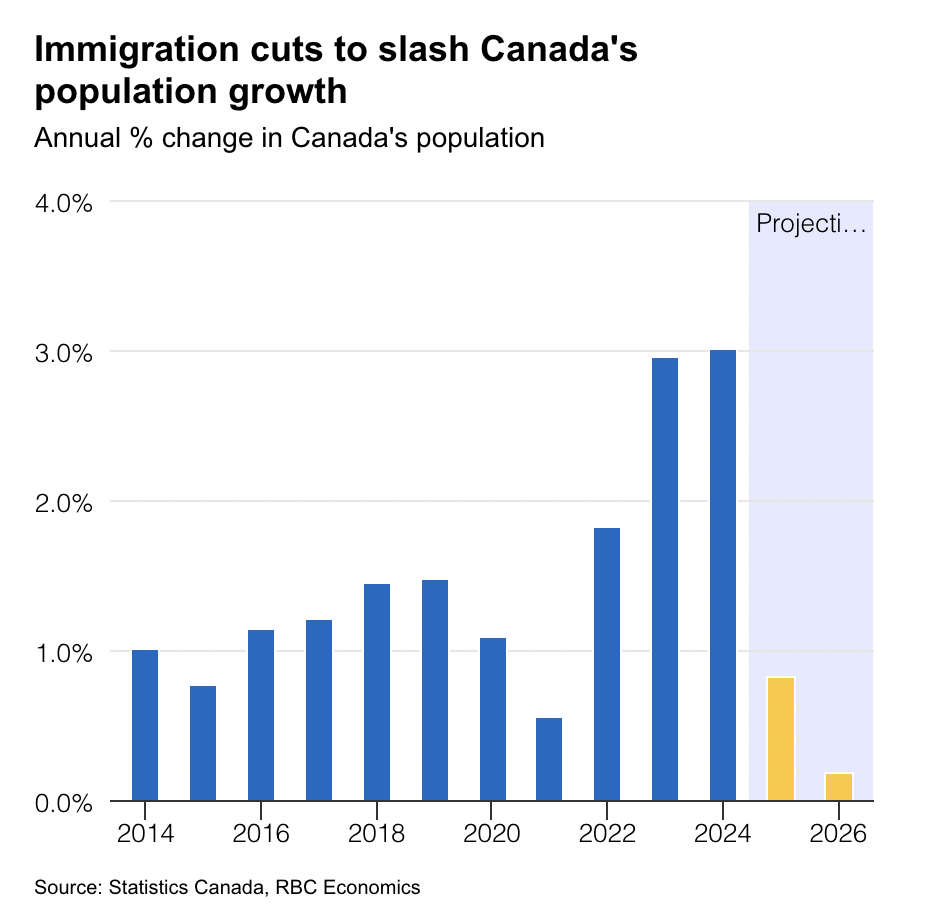The Canadian housing market finds itself at a critical juncture in 2025, as the threat of U.S. tariffs adds uncertainty to an already delicate economic environment.
According to RBC Economics, “the significant risk that tariffs pose to Canada’s economy casts a potentially dark shadow over the housing market.” With consumer confidence playing a pivotal role, potential economic turbulence could unsettle both buyers and sellers.
Robert Hogue, assistant chief economist at RBC, likened the housing outlook to “putting a price on a home before an earthquake—it’s hard to know what shape the structure will be in at the end of the day.” While the U.S. administration paused the implementation of blanket tariffs earlier this month, Hogue suggests the introduction of targeted measures, such as a 25 per cent tariff on Canadian steel and aluminum imports means that trade tensions aren’t going away anytime soon.
Lower interest rates
Aside from looming economic risks, some bright spots are emerging for Canada’s housing market. RBC predicts a recovery in 2025, fueled largely by declining interest rates. Lower borrowing costs are expected to unlock pent-up demand and reduce ownership expenses, bringing much-needed momentum into the market.

Buyers will also benefit from an increasing inventory of homes for sale. “These dynamics were set in motion in the second half of 2024 and have longer to run in the year ahead as we expect interest rates to fall further,” Hogue notes. Mortgage insurance rule changes, introduced in December, are also expected to bring more first-time homebuyers to the market.

Affordability, immigration cuts and tariff risks
Perhaps unsurprisingly, affordability challenges remain a hurdle. While lower rates provide some relief, RBC warns that “strained affordability—despite easing somewhat—will continue to limit buyers’ capacity or willingness to bid up prices aggressively.”
Compounding uncertainty is a sharp slowdown in immigration, as the federal government scales back annual targets. Population growth, a key driver of housing demand, is projected to decline substantially, and will likely “temper upward price pressure.”

The potential for U.S. tariffs adds another layer of complexity. Sectors heavily reliant on exports, such as manufacturing and natural resources, could face significant job losses, disproportionately affecting specific regions. In such a scenario, market confidence could take a hit.
However, RBC suggests that “ if a severe downturn prompts the Bank of Canada to implement deeper interest rate cuts, it could stimulate housing demand by making borrowing more affordable. The interplay between these forces—economic risk versus monetary stimulus—will be a key factor to watch in 2025.”
A return to normalcy for sales and prices
Barring a major economic shock, RBC forecasts a 12 per cent increase in national home resales in 2025, reaching 551,000 units—marking a return to “more normal levels of activity—about 7 per cent above the average during the five years preceding the pandemic.”
Property values, however, are expected to see minimal growth, with the average home price projected to rise 1.4 per cent this year. This modest price appreciation reflects a balanced market, with demand and supply largely offsetting each other.
RBC’s regional market outlook
British Columbia
Resales are expected to rebound 16.5 per cent, but affordability issues will limit price gains to 0.9 per cent.
Alberta
Strong momentum continues, with resales forecasted to rise 4.8 per cent and prices climbing 4.1 per cent.
Saskatchewan
Solid momentum persists, with resales projected to climb 6.7 per cent to 14,400 units, while prices are expected to rise 2.9 per cent to $370,200.
Manitoba
The market continues its recovery, with resales forecasted to grow 8.9 per cent to 17,200 units and prices appreciating 3.1 per cent.
Ontario
A bumpy recovery path is anticipated, with resales up 12.9 per cent, while prices are projected to increase by a muted 0.9 per cent.
Quebec
A strong rebound is underway, with resales forecasted to rise 17.3 per cent, following a 19.1 per cent surge in 2024. Prices are expected to increase 3.9 per cent, making Quebec one of the stronger performers among provincial markets.
Atlantic Canada
A broad-based rebound in activity is expected, with resales forecasted to grow 10.5 per cent in New Brunswick, 11.7 per cent in Nova Scotia, 5 per cent in Prince Edward Island, and 3.5 per cent in Newfoundland and Labrador. Price appreciation is projected to range from 1.5 per cent in PEI to 4.1 per cent in Newfoundland and Labrador.
Toronto’s embattled condo market
Toronto’s condo market, as we’ve heard, faces near-term challenges or “price softness,” as Hogue describes it. A surge in new completions, coupled with waning investor demand, could temporarily weigh on prices in highly saturated areas. Hogue predicts that “lower interest rates may eventually provide support, but the influx of units could create headwinds before broader market conditions stabilize.”
The mortgage renewal payment shock
Hogue expects a lingering concern for many homeowners in 2025 will be the financial strain associated with mortgage renewals. Borrowers who locked in ultra-low rates during 2020-2021 are likely to face significant payment increases at renewal, even as interest rates decline.
“This could force some owners to sell, adding to inventory and tempering price growth,” the economist explains. “However, Canada’s stringent mortgage stress test rules should help prevent a surge in distressed sales, keeping market imbalances generally in check.”

Jordana is the editor of Real Estate Magazine. You can reach her by email.
















Question.If the economy struggles the BOC will drop rates.How is this possible without killing the value of the dollar.Inorder to attract bond buyers won’t rates have to increase?In that scenario won’t staflation kick in?
Dan, my opinion is that the BoC will sacrifice the value of the Canadian dollar. A weaker dollar will help offset the impact of potential/actual tariffs to importers (especially in the US). The economic slack problem already exists in Canada. The dollar has already dropped 5 cents compared to the US in about 1 year. Economic recovery will become the focus. I actually think after a bottoming process for prices over the next 2 to 3 months, BoC benchmark rate will be at 2% vs 3% (now) and this will spur purchases for those who can afford homes. Key will be inventory levels. Expect price increases for Freeholds and price flatness to decline for Condos.
Now is the time to OPEN doors only to help the condo market !! January 2025 was the original date International investors had OPEN doors the purchase residential properties however that date was extended to 2026 them further extended to 2027. Our government needs to chance this immediately ONLY for Condo Market! To stimulate the starting point of the real estate market is the SALE of existing resale Condos. Canadians are struggling to realize their dream of home ownership. They remain in the rental market. We still need more housing to accommodate the massive amount of our immigration . The trade up market for 2nd 3rd 4th time Buyers is at a standstill because their properties cannot sell if condos are not selling.
PLEASE consider adopting an international Buyers investor program where they can ONLY purchase a Condo between April to December 2025 This will stimulate our market on various levels. The loss of value on the Condo inventory and owners facing high rising maintenance fees increases plus taxes will continue to cause financial strain. Bank of Canada hit variable rate customers extremely hard in the last 1 1/2 years. 100% of their Mortgage payment was Interest The same continues except now finally with the lowering of rates some principal is being contributed.
We desperately need our Condo real estate market flowing. This is a SOLUTION. I’ve seen it ALL as a Realtor over 40 years Our government needs to FIX their mistakes
What is the best option for renewable mortgages in 2025? Variable or Fixed? Personally I don’t know because once the tariffs come in then BOC might not lower rates as recession could creep in.
As an economist I can tell you that economists do not understand real estate markets. They never get it right.
Tariffs impacting consumer confidence, materials costs and investments hence willingness to buy // sell
What about looking at how the ban on foreign buyers for the last 2 years and ongoing until end 2026 has impacted the downtown centres of cities, particularly condos?
A weaker Canadian dollar might help offset the impact of tariffs to importers (especially in the US), but the downside may be that more of our precious natural resources, and Canadian owned companies will be gobbled up at ‘bargain basement’ prices by foreign investors. This may provide a temporary relief to unemployment, but not so great for our nation’s security. Foreign investment could also impact economic stability in certain regions, as has happened with the recent layoffs by Amazon. “1,700 full-time employees will lose their jobs as the e-commerce giant is to close all operations in the province, including its warehouses”. These kinds of events will have significant effects on real estate markets across the country.
Interesting that you won’t publish my recent comments. Are the facts too negative for you? I’m already seeing investors bailing out of projects here in Edmonton and there’s more to come.
Hi Lydia,
Thanks for your patience! To avoid delays in the future, we recommend creating a REM account—comments from registered users are published automatically.
Our team is enjoying a holiday today, so approvals for non-registered users are taking a little longer than usual. Appreciate your understanding.